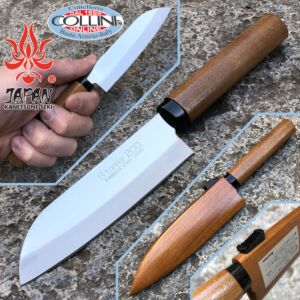Last up date
-
Weta Workshop - Ricette di Casa Baggins - Lo Hobbit - Il Signore Degli Anelli
Direttamente dalla Nuova Zelanda, i prodotti ufficiali con licenze cinematografiche Warner Bros e New Line Cinema del "Lo Hobbit" e de "Il Signore Degli Anelli" realizzati dalla Weta Workshop, lo studio che si occupa di ideare e realizzare fisicamente tutti gli oggetti di scena e gli effetti speciali per i film di Peter Jackson.
Gli Hobbit sono creature buffe e spensierate e tutto, per loro, ruota attorno al cibo. Ecco per voi tre tradizionali ricette custodite a Casa Baggins e cucinate con cura da Bilbo Baggins: * Agnello Stufato * Gallina Ripiena (o un altro volatile a vostra scelta) * Torta di Pasticceria Realizzate in pesante cartone lucido, le tre ricette - presenti anche nel film - sono state disegnate da Daniel Reeve e scansionate poi in alta definizione. Le misure delle tre ricette sono di 29.7x21cm ciascuna.10066 -
Weta Workshop - Map of the East Farthing - The Hobbit - 87-28-01191 - The Lord of the Rings
Direttamente dalla Nuova Zelanda, i prodotti ufficiali con licenze cinematografiche Warner Bros e New Line Cinema del "Lo Hobbit" e de "Il Signore Degli Anelli" realizzati dalla Weta Workshop, lo studio che si occupa di ideare e realizzare fisicamente tutti gli oggetti di scena e gli effetti speciali per i film di Peter Jackson.
Splendida mappa, realizzata in pesante carta pergamenata italiana di tipo "marina conghiglia" che ritrae i confini del Decumano Est della Contea degli Hobbit. Le dimensioni sono di 26x36cm.
Il Decumano Est il distretto orientale della Contea che si estende dalla Pietra dei Tre Decumani fino al corso del Brandivino.
Per gli Hobbit della Contea, il Brandivino fu sempre considerato come il confine tra il conosciuto e lo sconosciuto, e spesso coloro che vivevano nella Terra di Buck, anche se sulla sponda opposta, venivano considerati "strani".
Il nome Brandivino o Baranduin una parola sindarin che significa "fiume marrone dorato". Gli Hobbit della Contea gli diedero originariamente il nome di Branda-nn, "acqua di confine" nell'originale linguaggio Hobbitish. Questi cambi pi avanti ancora una volta il suo nome, diventando Bralda-hm, "birra inebriante" (nome, anche questo come quello sindarin, riferito al colore spesso marrone delle sue acque), che Tolkien rese in inglese con "Brandywine", diventato per traslitterazione Brandivino in italiano.
Nel Decumano Est sorgono le regioni dello Iale, la Palude, Terminalbosco, Campoponte e parte del Paese delle Verdi Colline; villaggi come Boschesi, Tassitani, Scary, Chianarana, Fossobianco, Scorta, Sirte, Fondangolo e Valsalice. Inoltre vi scorrevano l'Acqua, il Rio Cardo, il Rivo Lucente e il Rivo di Scorta.
Gli Hobbit del Decumano Est sono in gran parte di sangue Sturoi: grossi, con gambe pesanti e molti si fanno crescere una tipica barbetta. Inoltre, a quanto pare, furono i primi a creare fattorie e granai (nella Palude e lungo il Brandivino).
Curiosit: L'espressione strano come una notizia da Brea era comune nel Decumano Est.87-28-01191 -
Weta Worshop - An Unexpected Journey Print - 87-28-01038 - The Hobbit - The Lord of the Rings
Direttamente dalla Nuova Zelanda, i prodotti ufficiali con licenze cinematografiche Warner Bros e New Line Cinema del "Lo Hobbit" e de "Il Signore Degli Anelli" realizzati dalla Weta Workshop, lo studio che si occupa di ideare e realizzare fisicamente tutti gli oggetti di scena e gli effetti speciali per i film di Peter Jackson.
"Bilbo Baggins non lo sa ancora, ma fissa la sua amata Hobbiton e respira la fresca aria del mattino, la sua vita sta per cambiare. Drasticamente."
L'inizio di tutto, in un poster che riassume le grandi aspettative di un piccolo Hobbit, con uno desiderio di esplorare fuori dal comune, non compreso dai suoi concittadini e che nemmeno lui immaginava di avere.
Il designer Weta Gus Hunter, gi impegnato nella trilogia del Signore degli Anelli, si occupato di tradurre in immagine uno dei momenti salienti della nuova avventura cinematografica di Peter Jackson "Lo Hobbit: un viaggio inaspettato".
La stampa artistica, contenuta in un pratico e protettivo cilindro di cartone, realizzata su carta di elevata grammatura. Dimensioni: foglio 59 x 29,7 cm / stampa 53 x 23.5 cm.87-28-01038 -
Kanetsune - Cuchillo Ryou takumi - KB14 - collection kitchen
Kanetsune Seki produces traditional, high-quality kitchen spoons, suitable for daily use. These cuchillos are the result of the skill of craftsmen who implement scrupulous techniques. Our quality guarantees products that are exceptionally durable, sharp and of extraordinary beauty.
These cuchillos are destined to continually improve, fusing new ideas with traditional techniques transmitted over more than 800 years. Kitasho Co., Ltd. was founded in 1964 in the city of Seki, Japan, known as "The City of Swords", both nationally and internationally.
We constantly strive to offer short, durable and useful items, renewing our commitment to innovation in keeping with new times.
The range of products includes kitchen spoons, navajas, camping spoons, high-end cooking spoons for even the most refined palates, as well as tigers and shorts, and everyday items.
Intended use: home/collection
Type of artesanal production
Hoja: 33 head sanmai maple with Hitachi Aogami 64HRC carbon wire and 1095 brut de forge carbon maple shells.
Production of Japanese spoons
Mango: en madera de roble
Hoja length: 245 mm.
Hole thickness: 6 mm.
Closed length: -
Total length: 410 mm.
Balance: in the guard branch
Weight: 538g.
Cierre: -
Videos: -
Funda: madera de roble
Package: Black and red cardboard box with Kanetsune logos.
Note:-Characteristics of San Mai Maple: These are different types of metals combined to create a composition that contains and intensifies the resistance of the metals individually:
- Mayor vida útil del filo
Thanks to the use of very high quality maples with high carbon content (VG10, CoS, Shiro) or sintered (SPG2), in the core of the plate (Core Steel), the heat, once templada, has a hardness and a Decidedly superior court performance. which were achieved with the use of traditional maple trees.- Mayor resilience
Built according to the principle of Japanese swords, the multi-headed maple is difficult to break thanks to the hardness of the central maple (Core Steel) and the elasticity of the maple used for the lateral covering (Stainless Steel).- Better resistance to corrosion
The maple used for the external caps (Stainless Maple) guarantees the house a high resistance to corrosion. The combination of the two or more materials used by Takefu Steel generates, at the galvanic level, a structure that improves resistance to corrosion, including in the steel.- Easy processing including after heat treatment
Although the maple is normally hardened after the tempering, the lateral maple used in the multi-head process does not become softer and allows for easy mechanicalization, cutting or soldering even after the heat treatment. For optimal health performance, cryogenic treatment is recommended.- Improved aesthetic result
The cuchillos made with multi-layered maple or with damask pattern are aesthetically elegant, refined and much appreciated by collectors around the world at the end of the manufacturing process.For more information: collinsteel
KB-14 -
Kanetsune - Fruit Knife ST-200 - knife
Multi-purpose vegetable and fruit knife. Thanks to the wooden case (shirasaya), similar to the one used for the katana or the tanto, the blade remains perfectly protected and easily transportable.
Intended use: Sports / Collection
Blade: 420J2 steel
Japan blade production
Handle: cherry wood
Blade length: 105mm.
Blade thickness: 1mm.
Total length: 210mm.
Balancing: -
Weight: 36g.
Sheath: cherry wood sheath
Note:ST-200 -
Kanetsune - Kiridashi knife - KB612 - knife
Traditional Japanese carving knife "Kogatana" used in gardening, as a knife from the innseto or even for a walk and with a sharp blade only on one side. Thanks to the wooden case (shirasaya), similar to that used for the katana or for the time being, the blade remains perfectly protected and easily transportable.
Intended use: Sports / Collection
Blade: SK5 carbon steel
Lama Japan production
Handle: cherry wood
Blade length: 70mm.
Blade thickness: 2.5mm.
Total length: 165mm.
Balancing: -
Weight: 44g.
Sheath: cherry wood sheath
Note:KB612 -
BenchMark - Training Bali - BM006 - Training knife
*** ATTENTION: THE PAYMENT OF THIS ARTICLE MAY NOT 'BE MADE WITH PAYPAL ***
Intended Use: Training
Type of production: Industrial
Country of Origin: USA
Blade: stainless steel 420
Blade treatment: -
Handle: Full steel washers steel
Blade length: 95mm.
Blade thickness: 2.5mm.
Closed Length: 130mm.
Overall length: 230mm.
Thick when closed: 7.5mm
Weight: 165g.
Closed: T-latch
Packaging: Cardboard box with BenchMark logos
Notes: solid, sturdy, with hinged and riveted handles on the blade, great for making trick since it has the same weight, mass and balance of a real knife.BE-BM006










